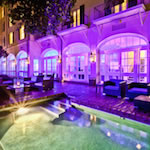Before an extensive renovation in 2010, the Hotel Le Marais in New Orleans was just another outdated French Quarter boutique.
“The hotel was well known as a sort of very low-end tourist hotel,” owner Joe Jaeger says. “It still had some shag carpeting and a very dated sort of French provincial look from its origins in the ’70s. Much was not working, including the air-conditioning system, which quit entirely about four months before we began serious renovations.”

In order to bring the interior décor into the 21st century, major updates and overhauls were needed throughout the 66-room hotel, resulting in a complete renovation. The overhaul included a name change—from the St. Ann/Marie Antoinette to the Hotel Le Marais, a nod to the famous district in Paris—and interior updates that would bring a new, contemporary look with simple lines and brighter colors to the overall scheme.
Jaeger says the biggest challenge was to come up with a look that feels contemporary but is still visually appropriate for the French Quarter. “We wanted guests to feel that they were still in New Orleans,” he says, “but a new, bolder, more modern New Orleans.”

First, new energy-saving elements were brought to the existing structure: old light bulbs were swapped out for energy-efficient ones, and windows were updated from single- to double-pane to reduce heat loss and insulate rooms from excessive outside noise.
Appearance-wise, some of the most subtle but important changes happened in the outdoor courtyard surrounding the saltwater pool. Heavy ballast stones used to create the patio were originally rounded on top, making it difficult for guests to comfortably move throughout the space. Instead of repaving, all of the central stones were ground down to a smooth, flat surface to encourage movement.
The design team also restricted the amount of foliage to the very edges of the yard to make the area feel less tropical and more open. The space is now a central gathering place for guests, connected directly to the inside bar and lounge through floor-to-ceiling glass doors.

In the guest rooms, bright purple and warm red colors weave throughout carpets, artwork, and furnishings to extend the feeling of vibrancy established in the public spaces to the private ones as well. Efforts were made to ensure that the small rooms feel spacious and welcoming despite typical French Quarter space restrictions; comfortable reading chairs and warm wood were used throughout each room.
Outdated bathrooms also got makeovers. The small, dull-looking tubs were removed and changed into large showers paved with black granite that “wears well and looks great,” Jaeger says.

The renovation has proved to be a success. The hotel is attracting its desired clientele. “Our first guests surprised us, as we were looking for a young, ‘hip’ crowd,” Jaeger says. “What happened was that we got an older ‘hip’ crowd. In fact, our average guest age is about 50 right now. These are empty-nesters, the new ‘young-old’ who are about traveling and finding new, active, authentic experiences. They want to be in the heart of things, and they do not want the old, tired, ‘French provincial’ look of the hotels they went to when they were youngsters.”
Since the positive reception of the Hotel Le Marais redesign, Jaeger has worked to incorporate similar elements into his other hotels in New Orleans (he owns a total of 13). His most recent acquisition, due for a major facelift in the first quarter of 2015, is the new Whitney Hotel located at Camp and Poydras streets.

